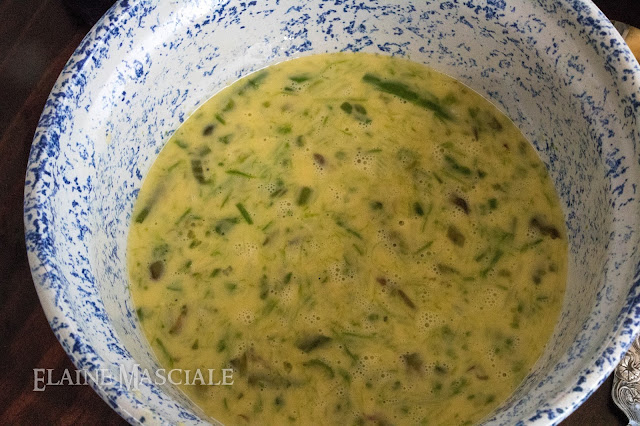Asparagus Omelet
A Historical Food Fortnightly Challenge
Having missed a couple of challenges, it's time to catch up. For this challenge, I made Asparagus Omelet
The Challenge:
Breakfast Foods (May 6 - May 19)
It’s simple - make a breakfast dish. Get creative, but make sure to provide your documentation for its place at the breakfast table!
 |
| "A Good Breakfast" by George Goodwin Clonney |
I set myself some additional criteria for this challenge: I knew that I would be making it at a reenactment (Greenfield Village's Civil War Remembrance weekend), so it had to be something I could prepare over an open fire. I wanted something on the simpler side, without a large number of specialized ingredients. Surrounding myself with food and material culture appropriate to the time and season is important to me, so whatever I made had to use seasonal ingredients appropriate to late May in the upper Midwest. The third additional criterion was that the breakfast had to be something my husband would really enjoy, since the day I planned on making it would be his birthday.
An egg-based food seemed the logical choice, since eggs are available in abundance in the spring. Not many fruits or vegetables are ripe yet in this area, but asparagus is.
The Recipe
I chose Asparagus Omelet from The Lady's Receipt Book of 1847 (Philadelphia), by Miss Eliza Leslie.
The challenge asked for documentation that the food would have been served at the breakfast table. I turned to the book Cookery as It Should Be, by A Practical Housekeeper (1856, Philadelphia) to find some suggested menus.

Challenges
The ingredients were easy to obtain; the difficult thing was calculating the quantity indicated by "two bunches" of asparagus. I discussed the question with a number of reenactors, and we determined a half a cup of cooked, chopped asparagus was the desired quantity
How I Made It
4 eggs
salt
evaporated milk (half a small can) A period source equated a small wine glass as half a gill, which makes it 1/4c.
half a bunch of asparagus
cayenne....well, I forgot it at home
butter for the pan - I substituted bacon grease
Since I only had one cast iron spider, I had to organize my cooking. First I set the asparagus to simmer in some water.
I cooked the asparagus for a longer time than I normally would. In this case I wanted the asparagus to be soft, so it would chop well.
Before cooking the omelet, I fried some slab bacon to grease the skillet. The bacon was quite lean, so there wasn't a lot of grease.
To make the omelet, I whisked 4 eggs with a serving fork and mixed in half a small can of evaporated milk. I chose the evaporated milk for two reasons - it is easier to transport than cream and it is my usual lower fat replacement for heavy cream. I whisked until light and bubbly.
I added the asparagus and mixed again. There should have been a pinch of cayenne, but I forgot it at home. I did ask at the neighboring tents, but no one had any.
I poured the egg/milk/asparagus mixture into the hot cast iron pan, using the bacon grease to keep it oiled. Watching the eggs carefully, I gently lifted the sides to let some of the raw egg flow under and cook.
Cost
one small can of evaporated milk - 99 cents
one bunch of asparagus - $3.00 (it was expensive that week)
Total - $4.50 (not counting the bacon)
How Accurate Was It?
First, I forgot the cayenne, but I'm not sure everyone would have added it in the time period. I substituted evaporated milk for the cream, which made the omelet less rich. Overall I have found evaporated milk to be a fairly good substitute for cream. The result is not 100% accurate, but I would estimate about 90%. Considering the fact that I cooked in a field, I think I gained bonus points.
How Successful Was It?
Tremendously! My beloved and I enjoyed it very much and I will gladly make it again.












Comments
Post a Comment